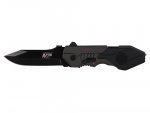[A] knife that contains a spring,... designed to create a bias toward closure of the blade [. And] that requires exertion ... in opening the knife.
Thanks for the citation to a federal law concerning a knife that must be pulled open. Reading skills ...
ETA:
http://www.politico.com/news/stories/1211/70483.html
I think you should ponder that a little more analytically sir. I own my fair share of assisted opening knives. Every one of them fits the description of the exemption while all of my unassisted knives don't. A non assisted knife isn't biased towards closure; you unlock the blade and it moves limply into the handle. Close an AO knife and you have to apply pressure to the mechanism until the bias takes over and pulls the blade into the handle.
Also, think more carefully about the second part of that sentence. "...that requires exertion applied to the
blade by hand, wrist, or arm to overcome the bias toward closure to assist in opening the knife." That second half isn't about the actual opening of the knife, its about
how its opened. As in not by a button, gravity, inertia, etc but by applying force to the
blade which would include something like a flipper or thumb stud. Example: A Microtech double action out the front knife is most positively a switchblade. It opens by the push of a button, but because it retracts back into the handle by power of a spring it is most certainly biased towards closure. If the exemption only said
"a knife that contains a spring, detent, or other mechanism designed to create a bias toward closure of the blade", the Microtech wouldn't be considered a switchblade because of that spring loaded closure. Even though it opens by the push of a button, the exemption would have made it legal. The second half is about excluding push button, gravity, inertial, etc knives from the assisted open exemption while allowing knives that open by force applied to the actual blade (flippers, thumb studs, etc).
Stow the attitude.


